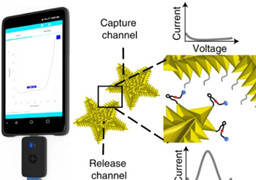[GT] нңҙлҢҖмҡ© н”Ңлһ«нҸјмқ„ мӮ¬мҡ©н•ҳлҠ” мҰүк°Ғм Ғмқё вҖҳм„ёк· к°җм—ј мӢ мҶҚ н…ҢмҠӨнҠёвҖҷ кё°мҲ к°ңл°ң
вҖҳл„ӨмқҙмІҳ мјҖлҜёмҠӨнҠёлҰ¬(Nature Chemistry)вҖҷ м Җл„җм—җ мөңк·ј л°ңн‘ңлҗң м—°кө¬м—җм„ң 1мӢңк°„ мқҙлӮҙм—җ м •нҷ•н•ҳкі мӢ лў°н• мҲҳ мһҲлҠ” кІ°кіјлҘј м–»мқ„ мҲҳ мһҲлҠ” вҖҳм„ёк· к°җм—јм—җ лҢҖн•ң нңҙлҢҖмҡ© мӢ мҶҚ н…ҢмҠӨнҠёвҖҷм—җ лҢҖн•ң кө¬мІҙм Ғ м„ӨлӘ…мқҙ мӢӨл ёлӢӨ.
мқҙлҘј нҶөн•ҳл©ҙ мӢӨн—ҳмӢӨм—җ мғҳн”Ңмқ„ ліҙлӮј н•„мҡ”к°Җ м—Ҷм–ҙм§Җкё° л•Ңл¬ём—җ, мӢӨм ң мһ„мғҒ мғҳн”Ңм—җм„ң мҡ”лЎң к°җм—јмқ„ 진лӢЁн•ҳлҠ” лҚ° мқҙ н…ҢмҠӨнҠёк°Җ л§Өмҡ° нҡЁкіјм Ғмқј кІғмңјлЎң ліҙмқёлӢӨ. м—°кө¬нҢҖмқҖ лӢӨлҘё нҳ•нғңмқҳ л°•н…ҢлҰ¬м•„лҘј к°җм§Җн• лҝҗл§Ң м•„лӢҲлқј, мҪ”лЎңлӮҳ л°”мқҙлҹ¬мҠӨлҘј нҸ¬н•Ён•ҳлҠ” к°Ғмў… л°”мқҙлҹ¬мҠӨмқҳ мӢ мҶҚн•ң 진лӢЁмқ„ мң„н•ҙ мқҙ н…ҢмҠӨнҠёлҘј нҳ„мһ¬ лҜём„ё мЎ°м •н•ҳкі мһҲлӢӨ. лҚ”л¶Ҳм–ҙ м—°кө¬мһҗл“ӨмқҖ м•”мқҳ н‘ңмӢқмқ„ нғҗм§Җн•ҳлҠ” лҚ°лҸ„ мқҙ н…ҢмҠӨнҠёк°Җ к°ҖлҠҘм„ұмқ„ к°–кі мһҲлҠ”м§Җ н…ҢмҠӨнҠён• кі„нҡҚмқҙлӢӨ.
л§Ҙл§ҲмҠӨн„° лҢҖн•ҷкөҗ(McMaster University)мқҳ м—°кө¬нҢҖмқҙ к°ңл°ңн•ң мқҙ мғҲлЎңмҡҙ кё°мҲ мқҖ мқҳмӮ¬к°Җ к°Җ진 мһ„мғҒ кІҪн—ҳмқ„ кё°л°ҳмңјлЎң мһҗмӢ мқҳ нҢҗлӢЁмқ„ л’·л°ӣм№Ён•ҳлҠ” лҚ° н•„мҡ”н•ң лҚ°мқҙн„°лҘј мӢ мҶҚн•ҳкІҢ м ңкіөн• кІғмқҙлӢӨ. лҳҗн•ң мқҙ кё°мҲ мқҖ нҷҳмһҗм—җкІҢ н•„мҡ” мқҙмғҒмқҳ нҳ№мқҖ л¶Ҳн•„мҡ”н•ң н•ӯмғқм ң мӮ¬мҡ©мқ„ м–өм ңн•ҳкі , лҚ” лӮҳмқҖ м№ҳлЈҢ, лҚ” л№ лҘё кІ°кіјлҘј м–»м–ҙ мӢ¬к°Ғн•ң н•©лі‘мҰқмқ„ н”јн•ҳкІҢ н• мҲҳлҸ„ мһҲлӢӨ.
мқҙ мғҲлЎңмҡҙ DNA кё°л°ҳ кё°мҲ мқҖ нҳҲлӢ№ мёЎм •кё°мҷҖ мң мӮ¬н•ң нңҙлҢҖмҡ© мһҘм№ҳлҘј мӮ¬мҡ©н•ҳлҠ”лҚ°, л§ҲмқҙнҒ¬лЎң칩мқҙ к°җм—јмқҳ нҠ№м • лӢЁл°ұм§Ҳ мӢ нҳёлҘј к°җм§Җн• мҲҳ мһҲлҠ” 분мһҗлҘј мӮ¬мҡ©н•ҳм—¬ нҳҲм•Ў, мҶҢліҖ, кё°нғҖ нғҖм•Ўкіј к°ҷмқҖ мІҙм•Ўмқ„ 분м„қн•ҳлҠ” кІғмқҙлӢӨ. мқҙ мһҘм№ҳлҠ” USB мҠӨнӢұ м •лҸ„мқҳ нҒ¬кё°лЎң мҠӨл§ҲнҠёнҸ°м—җ м—°кІ°н•ҳл©ҙ кІ°кіјк°Җ н‘ңмӢңлҗңлӢӨ.
кІ°кіјм ҒмңјлЎң, мқҙ мғҲлЎңмҡҙ кё°мҲ мқҖ м „кё°нҷ”н•ҷ кіөн•ҷ кё°мҲ кіј мғқнҷ”н•ҷ кё°мҲ мқ„ кІ°н•©мңјлЎң мқҙлӨ„м§ҖлҠ” кІғмқҙлӢӨ!
кё°мЎҙ кҙҖн–үмқҖ мқјл°ҳм ҒмңјлЎң мғҳн”Ңмқ„ мӢӨн—ҳмӢӨлЎң ліҙлӮҙ л°°м–‘н•ҙм•ј н•ҳлҠ” л°©мӢқмңјлЎң мқҙ кіјм •м—җлҠ” л©°м№ мқҙ мҶҢмҡ”лҗ мҲҳ мһҲлӢӨ. к·ёлҹ¬лӮҳ мқҙ мғҲлЎңмҡҙ кё°мҲ мқҖ нҷҳмһҗм—җкІҢ мҰүк°Ғм Ғ кІ°кіјлҘј м ңкіөн•ҳм—¬, к°җм—јмқҳ нҷ•мӮ°мқ„ мӨ„мқҙкі нҷҳмһҗмқҳ мӮ¶мқҳ м§Ҳмқ„ к°ңм„ н•ҳл©° л°”мҒң мһ„мғҒмқҳмқҳ м—…л¬ҙлҘј лӢЁмҲңнҷ”н• мҲҳ мһҲлӢӨ.
мқҙ мғҲлЎңмҡҙ кё°мҲ мқҖ н•ӯмғқм ңлЎң м№ҳлЈҢн• мҲҳ мһҲлҠ” лҸҷмқјн•ң л°•н…ҢлҰ¬м•„ к· мЈјлҘј н•ӯмғқм ңм—җ лӮҙм„ұмқҙ мһҲлҠ” лӢӨлҘё к· мЈјмҷҖ кө¬лі„н• мҲҳ мһҲмңјл©°, мқҙлҠ” мҰқк°Җн•ҳлҠ” н•ӯмғқм ң лӮҙм„ұ л¬ём ңлҘј н•ҙкІ°н•ҳлҠ” лҚ°лҸ„ лҸ„мӣҖмқҙ лҗ мҲҳ мһҲлӢӨ.
- NATURE CHEMISTRY, June 24, 2021, вҖңIntegrating programmable DNAzymes with electrical readout for rapid and culture-free bacterial detection using a handheld platform,вҖқ by Pandey, et al. © 2021 Springer Nature Limited. All rights reserved.
To view or purchase this article, please visit:
[GT] Integrating programmable DNAzymes with electrical readout for rapid and culture-free bacterial detection using a handheld platform
Research, just published in the journal Nature Chemistry, specifically describes a handheld rapid test for bacterial infections that can produce accurate, reliable results in less than an hour.
This eliminates the need to send samples to a lab, the testвҖҷs effectiveness in diagnosing urinary tract infections from real clinical samples. The researchers are adapting the test to detect other forms of bacteria and for the rapid diagnosis of viruses, including COVID-19. They also plan to test its viability for detecting markers of cancer.
This new technology developed by researchers at McMaster University will quickly give doctors the data they need to support what they already suspect based on their experience. This may also mean that patients can get better treatment, faster results and avoid serious complications while avoiding the unnecessary use of antibiotics.
The new DNA-based technology uses a handheld device similar to a blood-glucose monitor. A microchip analyzes a droplet of bodily fluid such as blood, urine or saliva, using molecules that can detect the specific protein signature of an infection. The device is about the size of a USB stick and plugs into a smartphone, which displays the results.
The invention combines electrochemical engineering technology with biochemical technology.
Existing practice typically requires sending samples to laboratories to be cultured, a process that can take days. Providing immediate results to patients can reduce the spread of infection, improve the patientsвҖҷ quality of life and simplify the work of busy clinicians.
The new technology can distinguish strains of the same bacteria that can be treated with antibiotics from others that are resistant to antibiotics, a critical distinction that can help battle the growing problem of antimicrobial resistance.
The researchers are in the midst of testing an adaptation of the same technology for the virus that causes COVID-19.
The researchers are exploring regulatory approvals and industry partnerships to get the technology into wide use around the world as quickly as possible.
- NATURE CHEMISTRY, June 24, 2021, вҖңIntegrating programmable DNAzymes with electrical readout for rapid and culture-free bacterial detection using a handheld platform,вҖқ by Pandey, et al. © 2021 Springer Nature Limited. All rights reserved.
To view or purchase this article, please visit:







